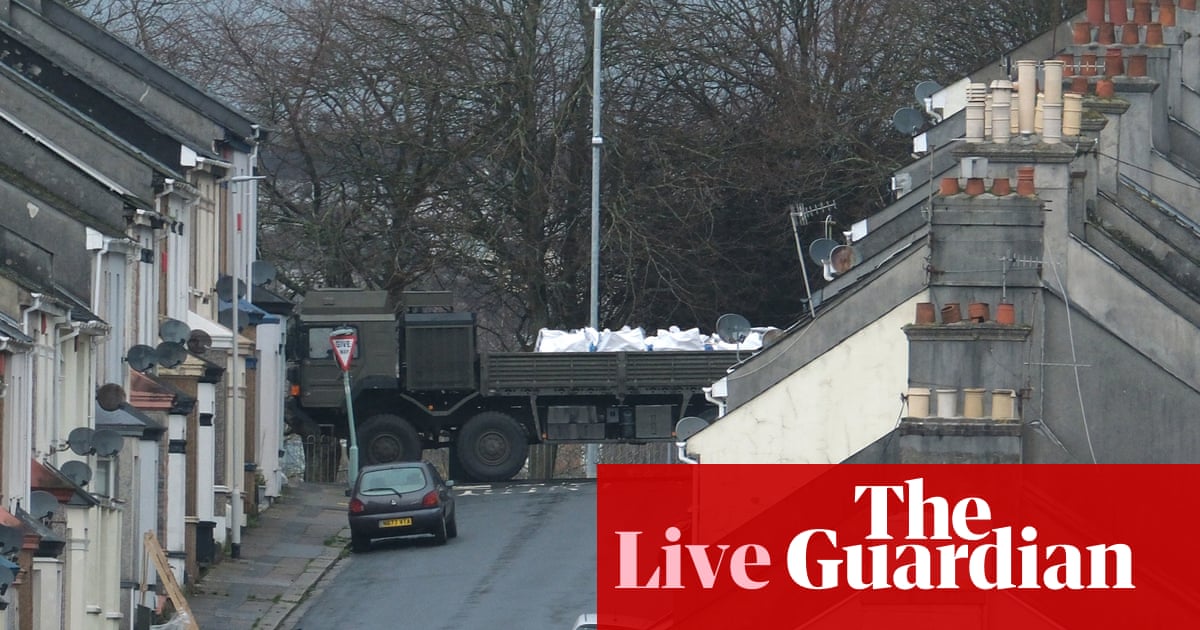
Police: Bomb will be detonated this evening or Saturday morning
Devon and Cornwall Police Superintendent Phil Williams, said the plan is for the bomb to be detonated this evening or tomorrow morning.
Although he added he does not “have all the details” as the military has taken over handling of the device.
Williams said the bomb has now been taken past the breakwater.
It reached the slipway at around 5pm when it was loaded from a military vehicle onto a boat.
A summary of today"s developments
An unexploded WW2 bomb that was found in a garden in Plymouth has been safely transferred to the sea after being transported on a military convoy through the streets of the port city in Devon, police said.
The 500kg device was moved from the Keyham area to the Torpoint Ferry slipway on Friday evening. It was taken to the sea and is expected to be detonated this evening or on Saturday morning.
Thousands of people who were evacuated from their homes have been told they can return to their properties after a 300m cordon set up around the disposal route was lifted.
More than 10,300 people and some 4,300 properties fell within the area that was cordoned off by police.
Devon and Cornwall Police Superintendent Phil Williams said the bomb has now been taken past the breakwater. It reached the slipway at around 5pm when it was loaded from a military vehicle onto a boat.
The Ministry of Defence described it as one of the largest UK peacetime evacuations since WW2.
Plymouth City Council said on Saturday the rest centre would move to the Beacon, in North Prospect, and the Life Centre currently being used would reopen to members and customers, the BBC reported.
The Beacon will be open from 08:00 to 20:00 GMT on Saturday and Sunday - with staff from Plymouth Community Homes, the council and Livewell Southwest offering advice and information, mental health support and help accessing food.
The underwater detonation of a Second World War bomb “might not be as Hollywood” as some spectators imagine, an army officer at the scene said.
Lieutenant Colonel Rob Swan told Sky News those who had gathered to watch the scene unfold “might see a jet of water on the surface” but it depended on the weather and sea conditions.
“Unfortunately it might not be as Hollywood as people would like to imagine,” he said.
Luke Pollard, MP for Plymouth Sutton & Devonport and the shadow armed forces minister, has paid tribute to the army and emergency services on X.
Lt Col Rob Swan, who has been leading the bomb disposal team, told the BBC the World War II bomb will be lowered into the sea to about 14 metres down before it is detonated.
He said it would happen “hopefully at some point this evening, or indeed tomorrow depending on the weather conditions”.
The leader of Plymouth City Council, Councillor Tudor Evans, thanked the armed forces for their bravery in carrying out the operation to remove the unexploded Second World War bomb from a garden and take it out to sea.
He said: “I think it is fair to say that the last few days will go down in history for Plymouth. This war-time bomb has really brought out the war-time spirit, people coming together to really support each other and whilst it has been really tough – we got through it!
I would like to thank the bomb experts for their bravery, putting their lives on the line to remove the WWII bomb from the garden in Keyham, carefully loading it onto a lorry, driving it slowly to the slipway so it could be loaded onto a boat, taking it out to sea so it could be safely detonated. As a naval city, this is a first-class example of why our armed forces are the best in the world.
“I would also to recognise all the other organisations who have demonstrated a stellar performance of community resilience and what it truly means to be a public servant. Hundreds of Council officers joined the small army of organisations that worked hand in hand to support the people of Keyham and keep our city safe.
“And finally – of course I would like to thank the people of Keyham, Ford and Devonport. It has been a rollercoaster of emotion the last few days, and I would like to praise the community for helping the emergency team in evacuating and supporting our effort to protect their home.
“It is a day I will never forget. I am so proud of Plymouth.”
Police: Bomb will be detonated this evening or Saturday morning
Devon and Cornwall Police Superintendent Phil Williams, said the plan is for the bomb to be detonated this evening or tomorrow morning.
Although he added he does not “have all the details” as the military has taken over handling of the device.
Williams said the bomb has now been taken past the breakwater.
It reached the slipway at around 5pm when it was loaded from a military vehicle onto a boat.
Usually as the weekend approaches, the streets, shops and pubs around Devonport, the largest naval dockyard in western Europe, hum with life.
But an eerie hush fell on the area on Friday after more than 10,000 people were evacuated from homes and workplaces so that a second-world-war bomb dropped on Plymouth by the Luftwaffe 80 years ago could be extracted from a back garden.
Police cleared parks, ferries stopped running, trains were halted, schools shut and there was a collective holding of breath as a military convoy transported the 500kg bomb – very slowly – through the terraced streets that tumble down to a slipway leading to the River Tamar.
From there, it was being gingerly floated out into Plymouth Sound, past Drake’s Island and the breakwater, to be detonated far away from the city’s streets.
It was a satisfactory conclusion to a difficult few days for the people who live near the back garden in the neighbourhood of Keyham where the bomb was discovered.
“Funny old week really, wasn’t it?” said Cassie Dunton, who works in a motorcycle shop close to the dockyard. “Strange times. You wonder how many more of these bombs are out there waiting to be found. What’s been nice is that everyone has stuck together. It’s a great community here. We look after each other.”
A man said he has gone to Devil’s Point in Plymouth with two friends to try to watch the bomb being taken out to sea and detonated.
Adam told BBC Radio Devon: “Since we came a couple of hours ago, it’s gone quite dark, so it is much, much harder to see.”
Devon and Cornwall Police has confirmed the successful military operation.
Rail services to and from Plymouth have restarted, National Rail has announced on social media, after the bomb was moved into the water.
Police chief superintendent Ian Drummond-Smith wrote on X said: “The bomb has gone to sea!
“Thank you to everyone for your patience and good spirits.”
Plymouth City Council said 10,320 people and 4,300 properties now fall within today’s cordon.
The initial planned cordon included 3,250 people and 1,219 properties.
A resident in Plymouth has written on social media that the bomb was discovered one metre from her dining room window.
The resident wrote on Facebook: “Words can’t even begin to describe the rollercoaster of emotions and turmoil we have been through these past few days!
“There is a lot of speculation about where the bomb is and we have kept quiet through the matter due to shock and not able to process what was happening but sadly have to say it is on our barrier wall between us and the neighbours garden, about 1M away from our dining room window.
“We’ve had meetings with the MOD to prepare us for the worst which meant we have totally had to gut our house yesterday with 25 military loading up removal vans which as you can imagine was overwhelming in itself, just chucking everything we own into box after box within 1 hour whilst of course it was absolutely lashing down!
The house looks like it’s been ran sacked with windows left open and sand bags piled for protection, chunks out doorframes damaged walls and filthy carpets but we will take this over having no house left at all.
“We were told the bomb could not be moved and will have to be detonated there and then which could result in our homes collapsing to the ground....words fail me for how this felt. As minimal damage will still require structural engineers to deem safe to return to our homes.
“They have been digging up around the bomb through the night and we now know as most of the city does too that they are going to be moving it to the breakwater which is the best news we could hope for but this does not mean we are safe yet as it is still active and could go off.”
Bomb convoy now on the move
The convoy is now on the move. Just previously Plymouth City Council said in a statement at bomb disposal experts were going to start moving the device.
The statement read:
We have been informed by the bomb disposal experts that the operation to remove the bomb will shortly commence.
We would like to thank everyone in the cordon area for leaving so swiftly.
We know that everyone will be keen to return to the area as soon as possible, but because it took slightly longer than expected to ensure the area was fully evacuated, we are anticipating that the lifting of the cordon will now happen at around 6.15pm.
Please do not start heading back to the area until we provide an update on this page that it is safe to do so. Even when the bomb has been removed, it will take some time to remove the cordon and would ask that people bear with us.
Why is the bomb here?
The large Naval Dockyard at Devonport and the presence of the Air Force and Army in the city made it a prime target for Hitler’s Luftwaffe. The people of Plymouth experienced their first air raid alert at 12.45am on 30 June 1940.
Between July 1940 and April 1944, the people of Plymouth experienced 602 alerts and 59 bombing raids, resulting in the deaths of 1174 civilians. More than 4,000 properties were destroyed with a further 18,000 damaged.
The heaviest bombing of the city occurred over seven nights in March and April 1941. During these seven nights alone, over 6000 general purpose bombs and 205,000 incendiary bombs were dropped on the city.
There is a fascinating “bomb book” that plots many of the raids. It was compiled during World War II by the town clerk’s department and is now in the city’s Box museum and gallery.
How did we get here?
The drama began when a builder hit a metallic object with a spade on St Michael Avenue, Keyham. At first he thought it was just a rusty piece of metal. On closer inspection the size and shape gave him pause and the police were called.
A major incident was declared by Plymouth city council on Tuesday afternoon and everyone who lived within 200m – about 1,200 people – was asked to leave their homes.
As the residents left, police officers, firefighters, more than 100 military personnel, including the Royal Navy Explosive Ordnance Disposal team, search and rescue teams and emergency response charities arrived. In all, about 1,000 professionals have been involved.
On Thursday, the cordon was extended, to precisely 309m, taking in 1,219 properties and an estimated 3,250 people. The council advised people to take any household documents with them, open windows (to reduce the chance of them breaking if there was a blast) and remove cars.
A rest centre was opened at the Life Centre leisure complex. The Red Cross arrived to help out.
People fretted about left-behind pets and photo albums and worried that their insurance wouldn’t cover an “act of war”. Resident Jordan Brett, who was staying in a hotel, said he was concerned about his rabbits. “If there’s a controlled explosion there, we’ll definitely have to get our two rabbits before that,” he said
But most were prepared to wait patiently, recapture a bit of the Blitz spirit Plymouth showed eight decades ago. “You need to sit tight,” said Matt Wake. “Be the best British people you can be – put the kettle on.”
This bomb is a big one – 500kg. And its position – wedged under fragmented concrete made it hard to deal with.
Andrew Barr, a research fellow who specialises in blast and impact dynamics at the University of Sheffield, told the Guardian a blast from the bomb was capable of destroying houses in the surrounding streets, and severely damaging water pipes and gas mains. Fragmentation of the steel casing could cause widespread damage and injury.
But moving the bomb was not without danger. Barr said: “There are certainly risks involved in handling the bomb and transporting it through densely populated parts of the city for disposal at sea. The decision to do so won’t have been taken lightly.”
The decision to move the bomb was signalled to everyone in the area via their mobile phones using the UK government’s severe alert system, which Devon and Cornwall police believes to be the first time it has been used for a real emergency.
People poured out of their houses and into cars to leave. “It feels a bit like one of those evacuations you see in a disaster movie,” said shop worker Steve Jones as he departed. “Only without the disaster, as long as they don’t hit one of those big potholes.”
The Guardian was stationed above the Torpoint Ferry in Devonport Park - but was told by police officers that it was too close and we were moved on.
Evacuation "one of largest since second world war", says MoD
The Ministry of Defence said the evacuation in Plymouth due to the unexploded bomb is one of the largest since the second world war.
In a statement on X, formerly Twitter, the MoD said: “One of the largest UK peacetime evacuation operations since WW2 is underway in Plymouth, where BritishArmy and RoyalNavy have been working round the clock to make safe a 500kg unexploded bomb.
“Personnel are working with plymouthcc & emergency services to evacuate residents.”
The main trainline will be closed as it travels through the cordon, while ferries will be suspended and buses will be diverted.
Schools and nurseries are to close to allow the operation to take place, while all businesses within the cordon have been told to evacuate, PA Media reported.
Giles Perritt, assistant chief executive Plymouth City Council, said more than 1,000 staff and officers were involved in the operation to safely remove the bomb.
He said: “Today is the result of an enormous amount of planning.
“You won’t be surprised to hear that officers and partners have been working around the clock since this incident started to come up with the best and safest solution to deal with this device.
“We’re all both excited and still planning for carrying out a successful operation today.”
“I believe that after an enormous amount of work, we’ve taken an approach which reduces the risk to human life and also reduces what might have been a devastating impact on properties around where the device is situated at the moment.
“I think we’ve come up with a solution that lowers the risk to the least amount. There are still risks that we face but we think we’ve managed them the best.
“I’d just at this time like to say that the colleagues from the military who will be at the wheel of that vehicle are taking risks that I think any of us would struggle to contemplate on a daily basis and my hat is absolutely off to them.”
Highly trained bomb disposal experts will carefully remove the bomb from the garden before it is transported by road in a military convoy.
An assessment found that if the bomb was detonated where it was found, there would be too high a risk of significant damage - including the destruction of a number of houses, the council said.
Those affected by the cordon should be able to return home by 5pm on Friday, with the military advice clear that they must leave for their own safety, PA Media reported.
Superintendent Phil Williams, of Devon and Cornwall Police, was speaking at a press conference at the cordon in Plymouth when the emergency alert rang out on mobile devices.
“As has been the way throughout this, we’ve not forced anyone to leave their home. All we can do is urge them to and offer them the best possible advice that we can,” he said.
Williams said the military convoy was expected to take 20 minutes as it moved the bomb from the garden to the sea.
An alert was sent to mobile devices in the area shortly after 12pm.
It read: “Severe Alert. Issued by Plymouth City Council.
“The WWII bomb found in Keyham will be transported today 23 February 2024 at 2pm to Torpoint Ferry slipway via Saltash Road.
“A time limited cordon will be in place along this route between 2pm until an estimated 5pm. You are asked to leave and stay away from the cordoned area for this time period.
“For more information about the route, cordon and support - go to the Plymouth City Council website. Visit gov.uk/alerts for more information.”
Emergency alert sent to people over unexploded second world war bomb
An emergency alert has been sent to mobile phones warning people nearby to evacuate as a suspected second world war explosive device is moved to be disposed of at sea.
Devon and Cornwall Police were called on Tuesday morning to St Michael Avenue in the Keyham area of Plymouth after the object was discovered in a garden, PA Media reported.
Since then, a 300-metre cordon has been put in place around the site - affecting 1,219 properties and an estimated 3,250 people.
On Friday, Plymouth City Council announced that the bomb would be taken by military convoy to the Torpoint Ferry slipway to be disposed of at sea.
People living within 300 metres of the route the bomb will travel have been told they must leave their homes by 2pm on Friday for their own city.
An alert was sent to mobile devices in the area shortly after 12pm on Friday, stating: “Severe Alert. Issued by Plymouth City Council.
“The WWII bomb found in Keyham will be transported today 23 February 2024 at 2pm to Torpoint Ferry slipway via Saltash Road.
“A time limited cordon will be in place along this route between 2pm until an estimated 5pm. You are asked to leave and stay away from the cordoned area for this time period.
“For more information about the route, cordon and support - go to the Plymouth City Council website. Visit gov.uk/alerts for more information.”












